An AHP-Based Methodology for Decision Support in Integrated Interventions in School Buildings
Abstract
1. Introduction
2. Methodology
- Definition of the problem, goals, and criteria;
- Determination of decisional variables and restrictions;
- Analysis of alternatives, estimates of values attributed to goals, criteria, and the final decision;
- Implementation of the decision and possible re-evaluation of the choice [34].
- Identification of the research purpose and determination of the choice goal.
- Definition of alternatives—i.e., the different steps that can be undertaken to provide a solution to the problem under investigation.
- Choice of criteria by which to evaluate alternatives. This phase implies a technical and intrinsic knowledge of the sector to which the alternatives to be compared belong.
- Compilation of the alternatives matrix (shown schematically in Table 1), made up of the generic element Mij. It will be of order nxm, where n corresponds to the number of rows, or alternatives, and m to the number of columns, or criteria. The operation involves assigning to each criterion the value it assumes in relation to the examined alternative.
- Transformation of qualitative judgements into quantitative judgements—i.e., the possible presence of non-numerical judgements counted in the matrix cannot be tolerated; consequently, such judgements must be translated into numbers. The process generally used to translate the qualitative data into numbers is to divide the range [0; 1] into a number of subsets equal to the number of judging alternatives and to assign to each alternative the average value that can be calculated for each subset. For example, in the case of 3 alternatives (1. low, 2. medium, 3. high), the definition range [0, 1] should be divided into three sub-ranges:[0; 1] → [0; 0.333] ∪ [0.333; 0.666] ∪ [0.666; 1].The first value is defined considering the arithmetic average of the first interval:
- (1)
Similarly, this proceeds for the second value, considering obviously the second interval:- (2)
For the third interval, the procedure is the same:- (3)
- Normalization of the alternatives matrix, as shown in Table 2. The aim of this process is to compile a matrix in which the numbers in the range [0; 1] appear. In this phase, it is necessary to pay attention to the identification of the minimum and maximum value for each column of the alternatives matrix. These values will then be used to normalize the criteria according to whether they are a cost or a benefit. Particular attention must be paid to the subdivision of the criteria into two distinct types based on “cost” or “benefit” parameters. In fact, in case a criterion is qualified as a cost to be sustained, this receives a negative connotation, and it is necessary to make sure that its value is minimized, reducing it according to the Formula (1):where Mj,min = min(i) Mij.Mij*= Mj,min/Mij,Instead, when using a criterion capable of making a benefit, a positive contribution, it will tend to maximize its effects by adopting the Formula (2):Mij*= Mij/Mj,max,where Mj,max = max(i) Mij.
- Assigning weights to criteria.
- Resolution of the alternatives matrix, which consists of the application of the Simple Additive Weighing method. This procedure makes it possible to evaluate the product between each element of the alternatives matrix and the respective weight column.
- Determination of the index of preference, Ip, obtained as the sum of the values traceable in each line of the alternatives matrix.
- Finding the solution to the problem by reading the highest Ip.
3. Definition of Evaluation Criteria and Indicators
- ζ—SEISMIC SAFETY LEVEL: this criterion is intended to investigate the structural response of the building being examined;
- EP—ENERGY PERFORMANCE: this criterion has the task of making a comparison between the indices of non-renewable primary energy consumption related to the different project alternatives;
- CT—INTERVENTION COST: the criterion considers the total costs necessary for the realization of the intervention in exam; within this item are also included the costs necessary for extraordinary maintenance;
- EIMP—ENVIRONMENTAL IMPACT: this criterion considers the quantity of waste produced and the percentage of recovered material that can be obtained from it;
- TR—REALIZATION TIME: the criterion weighs the time necessary to the realization of the proposed intervention;
- D—DISTURBANCE: this criterion measures the disturbance level caused to the different activities that take place inside the building, evidently in contrast with the planned interventions.
- The project is the result of the knowledge gained at the time of its construction;
- The original project could already contain technical or conceptual setting errors, even not directly visible;
- The building under study may have been the subject of accidental events, the effects of which are not apparent;
- It is possible to find faults in the construction and packaging of structural materials;
- The materials’ quality and characteristics are not reliable;
- There may be degradation and deterioration of materials that are not always evident;
- There are some uncertainties regarding the foundation system;
- Structural changes may have occurred that are not always properly documented.
- EPgl,nren= global non-renewable primary energy, or “Consumption Index”, useful to establish the relationship between the energy needed to bring an environment to the comfort temperature and its usable surface;
- EPHnren = non-renewable primary energy for winter air conditioning;
- EPCnren= non-renewable primary energy for summer air conditioning;
- EPWnren = non-renewable primary energy for the production of domestic hot water;
- EPVnren = non-renewable primary energy for ventilation;
- EPLnren= non-renewable primary energy for artificial lighting;
- EPTnren= non-renewable primary energy for the transport of people or things.
- Ct represents the value at current prices of the initial costs to be reconstructed after n years;
- r is the discount rate in cents;
- n is the number of years that pass from the analysis date to the cost occurrence.
- An represents the final accumulation—i.e., the total sum needed for a given extraordinary maintenance work;
- a indicates the single annuity to be supported according to the need of the analyzed component;
- q is the unitary amount, the sum of the capital and the interests accrued in a certain time unit;
- n is the number of annuities that are added together;
- r is the interest rate set at 4%.
- Definition of a target for the inert waste recovery of 70% to be reached by 2020;
- Introduction of the end of waste concept.
4. Implementation of the Methodology to a Case Study
- (a)
- Alternative 1—(A1): provides for a seismic improvement of the structure and energy requalification of the building in accordance with current regulations [40]. Specifically, the following technical measures are envisaged:
- Structural consolidation through Carbon Fiber Reinforced Polymer (CFRP) systems for seismic improvement;
- Installation of PVC windows with thermal break, equipped with double low-emissivity glass and double glazing;
- Exterior insulation finishing system for the entire external surface of the building by using a high-performance insulating panel made of 80 mm-thick rock wool;
- Application of thermal insulation in correspondence of the roof slabs consisting of mineral insulating panels, water-repellent, treated with thermosetting resin based on organic and vegetable components, 100 mm thick;
- Installation of new classroom doors in accordance with the dimensions determined by the current regulations [50];
- Replacing lights with modern energy-saving LED lamps;
- Replacement of the existing boiler with a new condensing model of equal power.
- (b)
- Alternative 2—(A2): the hypothesis of seismic improvement is again taken into account, however, it was decided to upgrade the energy efficiency in order to give higher energy performance than the previous alternative. Specifically, the following technical measures are foreseen:
- Structural consolidation through CFRP systems for seismic improvement;
- Installation of new thermal break PVC window frames, equipped with double low-emissivity glass and double glazing filled with argon;
- Exterior insulation finishing system for the entire external surface of the building by using a high-performance insulating panel made of 80 mm-thick rock wool;
- Application of thermal insulation in correspondence of the roofing slabs consisting of very high-density mineral insulation panels, water-repellent, treated with thermosetting resin based on organic and vegetable components, 100 mm thick;
- Installation of new classroom doors in accordance with the dimensions established by the current regulations [51];
- Replacing lights with modern energy-saving LED lamps;
- Replacement of the existing boiler with a new condensing model of equal power;
- Installation of a new crawl space with a ventilated cavity in correspondence of the first floor;
- Demolition of the partition walls in order to replace them with similar structures built dry and equipped with acoustic insulation in compliance with current standards [52].
- (c)
- Alternative 3—(A3): consists of the complete demolition of the building and its reconstruction through a reinforced concrete framed structure. The demolition technique adopted will be the classic one.
- (d)
- Alternative 4—(A4): provides for the total demolition of the building and its complete reconstruction through a reinforced concrete framed structure. This alternative differs from the previous one since, in this case, a selective demolition intervention will be arranged.
- The realization of a crawl space for the correct thermal insulation of the building.
- Thermal insulation in mineralized wood fiber panels bonded with 80 mm-thick Portland concrete with special expedients for the thermal bridge removal.
- Flat roof with a ventilated cavity. The insulating layer is made of natural toasted cork panels with a thickness of 120 mm. A surface finishing layer made with a thermo-reflective aerogel paint.
- The transparent closures are replaced with PVC thermal break windows with double low-emissivity glass and argon-filled glazing.
- With regard to the technological systems, some technical hypotheses have been adopted aimed at reducing the energy needs of the school facility. For this purpose, the installation of the following components is considered: a photovoltaic system consisting of amorphous panels integrated in the roof covering, equipped with storage batteries or direct connection for energy feed into the grid; a rainwater recovery system with a collection and storage plant for irrigation and sanitary facilities; an electric heat pump generator with compression and high COP; a heating/cooling system with fan coils, divided into zones, with an integrated system of temperature, humidity, and radiation control; an integrated system of automatic management of the indoor natural ventilation with energy recovery and incoming air pre-treatment; an LED lighting system with presence and brightness sensors.
5. Discussion
- The seismic safety level favors those project alternatives that provide for a new construction, as they are made according to current criteria and standards. Moreover, the presence of upwind walls built as part of a structural intervention following the 1980 seismic event in Irpinia greatly alters the seismic response of the existing structure. This makes the evaluation of the structure’s post-elastic reserves very complex. This criticality leads to an understanding of the complexity in the definition of the indicators associated with the criteria, since the first must be able to catch the nature of problems very often articulated.
- One of the criteria that pushes more towards the choice of the optimal project hypothesis is the environmental impact indicator. This information is closely linked to the amount of waste produced and the amount of waste removed from the landfill and then recovered. This kind of process requires the precise and accurate knowledge of the waste recovery cycles. In this study, the general characteristics of the demolition phases have been examined, not entering into the specific costs, but only parametric, linked to the recovery process or environmental impact.
- It is clear that the ordering of alternatives is influenced by the distribution of relative weights and depends on the experts’ discretion in relation to the specific case. This, at the same time, gives, however, extreme flexibility to the method, which does not claim to return the univocal solution of a problem but to orient in a structured and rational way towards those solutions that best satisfy specific goals.
- In addition, the method is “open”, i.e., it can be implemented with additional evaluation criteria and the introduction of different needs and objectives.
6. Conclusions
Author Contributions
Funding
Conflicts of Interest
References
- BPIE. Europe’s Buildings under the Microscope; BPIE, Building Performance Institute Europe: Bruxelles, Belgium, 2011; Available online: http://bpie.eu/publication/europes-buildings-under-themicroscope/ (accessed on 15 July 2020).
- EUROSTAT. Your Key to European Statistics. Available online: https://appsso.eurostat.ec.europa.eu/nui/show.do?dataset=educ_uoe_enra01&lang=en (accessed on 10 September 2020).
- Kephalopoulos, S.; Csobod, E.; Bruin, Y.B.d.; Fernandes, E.D.O. Guidelines for Healthy Environments within European Schools; Publications Office of the European Union: Luxembourg, 2014. [Google Scholar]
- Trachte, S.; De Herde, A. Sustainable Refurbishement School Buildings: A Guide for Designers and Planners; IEA SHC, Presses Universitaires de Louvain UCL: Louvain, Belgium, 2015; pp. 6–14. [Google Scholar]
- Parma Declaration on Environment and Health. Protecting children’s health in a changing environment. In Proceedings of the Fifth Ministerial Conference on Environment and Health, Parma, Italy, 10–12 March 2010. [Google Scholar]
- EU Science Hub. The European Commission’s Science and Knowledge Service. Available online: https://ec.europa.eu/jrc/en/publication/eur-scientific-and-technical-research-reports/sinphonie-schools-indoor-pollution-and-health-observatory-network-europe-final-report (accessed on 5 September 2020).
- Nucci, L.; Galimberti, L. Towards a new school’s role in the Italian contemporary city. City Territ. Arch. 2020, 7, 1–13. [Google Scholar] [CrossRef]
- MIUR. Istituzione Edilizia Scolastica. Available online: https://www.istruzione.it/edilizia_scolastica/anagrafe.shtml (accessed on 20 September 2020).
- MIUR. Gestione Patrimonio Informativo e Statistica, Rapporto Statistica e Studi MIUR, 2016–2017. Available online: https://www.miur.gov.it/dati-statistici (accessed on 20 September 2020).
- Nuvec. Nucleo Verifica e Controllo, Task Force Edilizia Scolastica, Rapporto ARES, Agenzia per la Coesione Territoriale 2018. Available online: https://www.istruzione.it/edilizia_scolastica/index.shtml (accessed on 22 September 2020).
- ISTAT. Istituto Nazionale di Statistica. Available online: https://www.istat.it/it/archivio/scuola (accessed on 9 September 2020).
- ISTAT. Istituto Nazionale di Statistica. Available online: https://www.istat.it/ (accessed on 9 September 2020).
- MIUR. Gestione Anagrafe Dell’edilizia Scolastica, ARES. Available online: https://dati.istruzione.it/opendata/opendata/catalogo/elements1/?area=Edilizia%2520Scolastica&&pk_vid=8e3619b0009a8fca1537956759f27725 (accessed on 5 February 2020).
- Déom, C. Partners in Preservation: University of Montreal Research for the Preservation of the Montreal School Board Historic Schools. Int. J. Herit. Stud. 2008, 14, 573–588. [Google Scholar] [CrossRef]
- Ireland, T.; Brown, S.; Schofield, J. Introduction: (In)significance-values and valuing in heritage. Int. J. Herit. Stud. 2020, 26, 823–825. [Google Scholar] [CrossRef]
- Mu, E.; Pereyra-Rojas, M. Practical Decision Making Using Super Decisions v3. An Introduction to the Analytic Hierarchy Process; Springer International Publishing: New York, NY, USA, 2018. [Google Scholar] [CrossRef]
- Panahi, M.; Rezaie, F.; Meshkani, S.A. Seismic vulnerability assessment of school buildings in Tehran city based on AHP and GIS. Nat. Hazards Earth Syst. Sci. 2014, 14, 969–979. [Google Scholar] [CrossRef]
- Yazdi, M.H.Z.; Dehkordi, M.R.; Eghbali, M.; Amiri, G.G. Fuzzy-Based Seismic Risk Prioritization of Steel School Buildings. Nat. Hazards Rev. 2021, 22, 04020044. [Google Scholar] [CrossRef]
- Yariyan, P.; Zabihi, H.; Wolf, I.D.; Karami, M.; Amiriyan, S. Earthquake risk assessment using an integrated Fuzzy Analytic Hierarchy Process with Artificial Neural Networks based on GIS: A case study of Sanandaj in Iran. Int. J. Disaster Risk Reduct. 2020, 50, 101705. [Google Scholar] [CrossRef]
- Gentile, R.; Galasso, C.; Idris, Y.; Rusydy, I.; Meilianda, E. From rapid visual survey to multi-hazard risk prioritisation and numerical fragility of school buildings. Nat. Hazards Earth Syst. Sci. 2019, 19, 1365–1386. [Google Scholar] [CrossRef]
- Ilumin, R.C.; Oreta, A.W.C. A Post-Disaster Functional Asset Value Index for School Buildings. Procedia Eng. 2018, 212, 230–237. [Google Scholar] [CrossRef]
- Samad, A.M.; Hifni, N.A.; Ghazali, R.; Hashim, K.A.; Disa, N.M.; Mahmud, S. A study on school location suitability using AHP in GIS approach. In Proceedings of the IEEE 8th International Colloquium on Signal Processing and Its Applications, Melaka, Malaysia, 23–25 March 2012; pp. 393–399. [Google Scholar]
- Bukhari, Z.; Rodzi, A.M.; Noordin, A. Spatial Multi-Criteria Decision Analysis for safe school site selection. J. Pengur. Kep. Pendidik. Int. Geoinform. Res. Dev. J. 2010, 1, 91–108. [Google Scholar]
- Rosa, L.V. Assessing the Sustainability of Existing Buildings Using the Analytic Hierarchy Process. Am. J. Civ. Eng. 2013, 1, 24. [Google Scholar] [CrossRef]
- Marzouk, M.; Awad, E. Establishing Multi-level Performance Condition Indices for Public Schools Maintenance Program Using AHP and Fuzzy Logic. Stud. Inform. Control. 2016, 25, 343–352. [Google Scholar] [CrossRef]
- Lopez-Chao, V.; Lorenzo, A.A.; Saorin, J.L.; De-La-Torre-Cantero, J.; Díaz, D.M. Classroom Indoor Environment Assessment through Architectural Analysis for the Design of Efficient Schools. Sustainability 2020, 12, 2020. [Google Scholar] [CrossRef]
- Cochran Hameen, E.; Ken-Opurum, B.; Son, Y.J. Protocol for Post Occupancy Evaluation in Schools to Improve Indoor Environmental Quality and Energy Efficiency. Sustainability 2020, 12, 3712. [Google Scholar] [CrossRef]
- Hassan, A.; Yahya, M. Cost optimization for public school building projects during design stage using value engineering. MATEC Web Conf. 2018, 162, 02033. [Google Scholar] [CrossRef][Green Version]
- Guarini, M.R.; Morano, P.; Sica, F. Historical School Buildings. A Multi-Criteria Approach for Urban Sustainable Projects. Sustainability 2020, 12, 1076. [Google Scholar] [CrossRef]
- Belleri, A.; Marini, A. Does seismic risk affect the environmental impact of existing buildings? Energy Build. 2016, 110, 149–158. [Google Scholar] [CrossRef]
- Fiore, P.; Donnarumma, G. Proposal of a multicriteria decision-making approach for the choice between refurbishing or reconstructing an existing building. Tema Technol. Eng. Mater. Archit. 2018, 4, 36–46. [Google Scholar]
- Donnarumma, G.; Fiore, P. Reorganisation and regeneration of the school building heritage in the associated management between small Municipalities: An integrated and multi-criteria approach. Valori E Valutazioni 2020, 25, 83–90. [Google Scholar]
- Greco, S.; Ehrgott, M.; Figueira, J.R. Multiple Criteria Decision Analysis. State of the Art Surveys, 1st ed.; Springer: New York, NY, USA, 2016. [Google Scholar]
- Falcone, D.; De Felice, F.; Saaty, T.L. Il Decision Marketing e i Sistemi Decisionali Multicriterio. Le Metodologie AHP e ANP, 1st ed.; Hoepli: Milano, Italy, 2009. [Google Scholar]
- Saaty, T.L. Multicriteria Decision Making—The Analytic Hierarchy Process. Planning, Priority Setting, Resource Allocation, 1st ed.; RWS Publishing: Pittsburgh, PA, USA, 1988. [Google Scholar]
- Ching-Lai, H.; Kwangsun, Y. Multiple Attribute Decision Making, 1st ed.; Springer: New York, NY, USA, 1981. [Google Scholar]
- De Feo, G.; De Gisi, S. Using an innovative criteria weighting tool for stakeholders involvement to rank MSW facility sites with the AHP. Waste Manag. 2010, 30, 2370–2382. [Google Scholar] [CrossRef] [PubMed]
- Circolare 21 Gennaio 2019, n. 7 C.S.LL.PP. Istruzioni per L’applicazione dell’«Aggiornamento delle “Norme Tecniche per le Costruzioni”» di cui al Decreto Ministeriale 17 Gennaio 2018; Ministro delle Infrastrutture e dei Trasporti: Roma, Italy, 2019.
- Decreto 17.10.2018. Aggiornamento delle «Norme Tecniche per le Costruzioni»; § 2.4.1, Ministero delle Infrastrutture e dei Trasposrti: Roma, Italy, 2018; p. 40.
- DM 26/06/2015 Applicazione delle metodologie di calcolo delle prestazioni energetiche e definizione delle prescrizioni e dei requisiti minimi degli edifici. In Adeguamento Linee Guida Nazionali per la Certificazione Energetica Degli Edifici; Allegato 1, Ministro dello Sviluppo Economico di concerto con i Ministri dell’Ambiente e della Tutela del Territorio e del Mare, delle Infrastrutture e dei Trasporti, Della Salute e della Difesa; Roma, Italy, 2015. Available online: https://www.mise.gov.it/index.php/it/normativa/decreti-interministeriali/2032966-decreto-interministeriale-26-giugno-2015-applicazione-delle-metodologie-di-calcolo-delle-prestazioni-energetiche-e-definizione-delle-prescrizioni-e-dei-requisiti-minimi-degli-edifici (accessed on 10 February 2020).
- UNI/TS 11300-2:2019. Energy Performance of Buildings. Available online: https://www.cti2000.eu/la-uni-ts-11300/ (accessed on 22 September 2020).
- CTI. Comitato termotecnico Italiano 14:2013 Raccomandazione, Prestazioni Energetiche Degli Edifici, Determinazione Della Prestazione Energetica Per La Classificazione Dell’edificio. Available online: https://www.cti2000.it/index.php?controller=pubblicazioni&action=show&id=13756 (accessed on 22 September 2020).
- Determinazione Dei Costi Standard Per Lavori Pubblici, Autorità per la Vigilanza sui Contratti Pubblici di Lavori, Servizi e Forniture (Avcp): Roma, 2003. Available online: https://www.anticorruzione.it/portal/public/classic/Attivitadocumentazione/Pubblicazioni/RapportiStudi/_definizioneCosti/ (accessed on 10 February 2020).
- “Prezzario Reginale dei Lavori Pubblici, Costi Parametrici ed Incidenza Della Manodopera Nelle Varie Categorie di Lavori”, Regione Veneto, 2019. Available online: https://www.regione.veneto.it/web/lavori-pubblici/prezzario-regionale (accessed on 10 February 2020).
- Costi Standardizzati per Tipologie di Opere Pubbliche, Ufficio Ripartizione Edilizia e Servizio Tecnico, Agenzia per l’Italia Digitale, Amministrazione Provincia di Bolzano, 2019. Available online: http://www.provincia.bz.it/costruire-abitare/edilizia-pubblica/servizi/costi-standardizzati.asp (accessed on 10 February 2020).
- Caterino, N. Analisi Decisionale Multicriterio per L’adeguamento Sismico di Edifici in c.a. Ph.D. Thesis, Università degli studi di Napoli Federico II, Napoli, Italy, 2006. [Google Scholar]
- D.Lgs. n. 205/2010. Disposizioni di Attuazione Della Direttiva 2008/98/CE del Parlamento Europeo e del Consiglio del 19 Novembre 2008 Relativa ai rifiuti e che Abroga Alcune Direttive. Available online: https://www.camera.it/parlam/leggi/deleghe/testi/10205dl.htm (accessed on 16 March 2020).
- Da Maglia, S. La Gestione dei Rifiuti Dalla A alla Z, 5th ed.; Edizioni TuttoAmbiente: Piacenza, Italy, 2018. [Google Scholar]
- Decreto della Giunta Regionale n. 265 del 28.07.1998, Regione Toscana. Available online: https://www.regione.toscana.it/documents/ (accessed on 16 March 2020).
- Dm 26 Agosto. Norme di Prevenzione Incendi per L’edilizia Scolastica; Ministero dell’Interno Dipartimento dei Vigili del Fuoco, del Soccorso Pubblico e della Difesa Civile Direzione Centrale per la Prevenzione e la Sicurezza Tecnica: Roma, Italy, 1992.
- Graffeo, M.; Baldoli, S. Analisi Critica Della Norma UNI 11367 per la Classificazione Acustica Delle Unità Immobiliari. Master’s Thesis, Politecnico di Milano, Milano, Italy, 2012. [Google Scholar]
- Saaty, T.L. A Scaling Method for Priorities in Hierarchy Structures. J. Math. Psychol. 1977, 15, 234–281. [Google Scholar] [CrossRef]
- Saaty, T.L. Deriving the AHP 1–9 scale from first principles. In Proceedings of the ISAHP 2001, Berne, Switzerland, 2–4 August 2001. [Google Scholar]
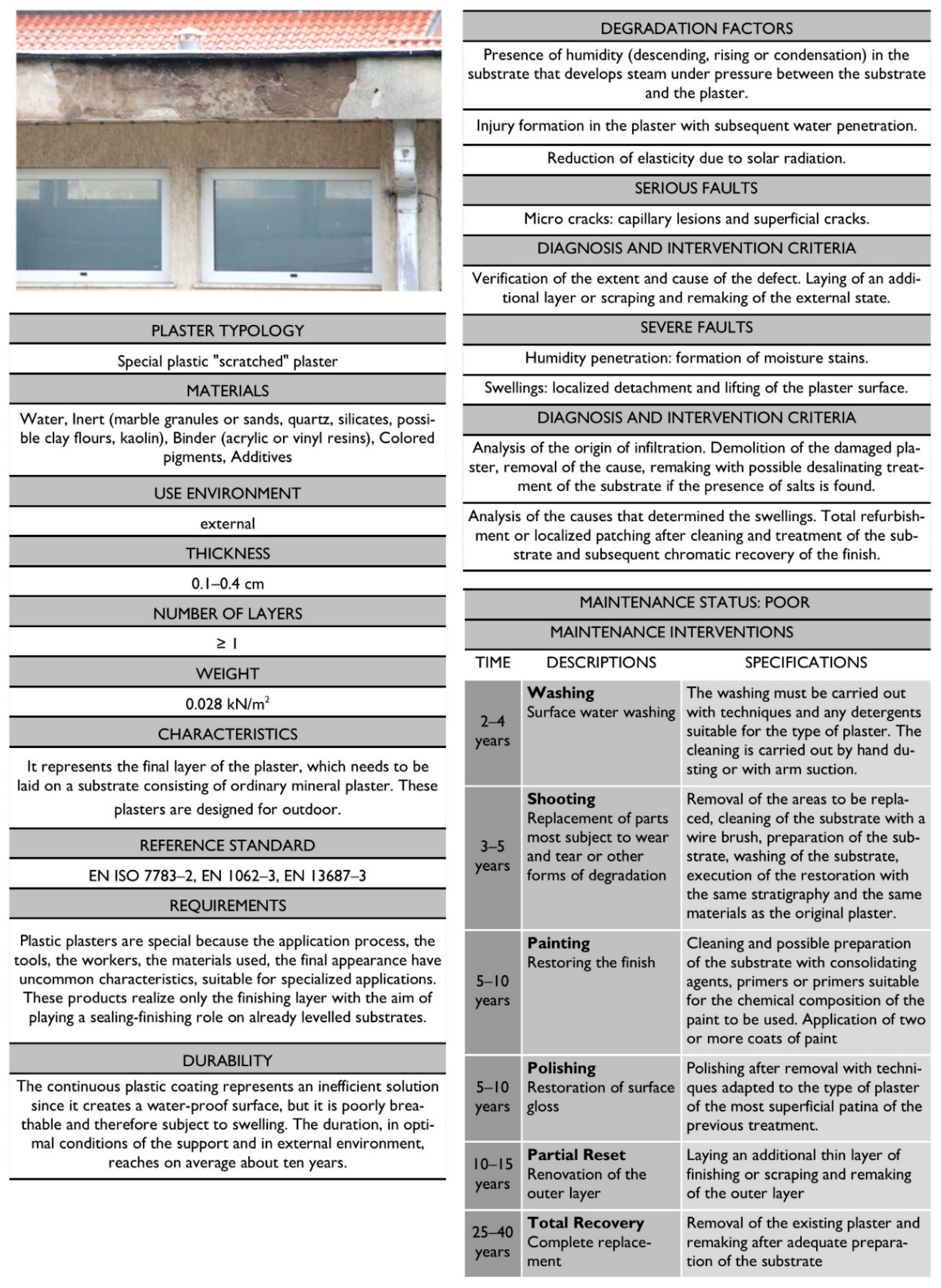
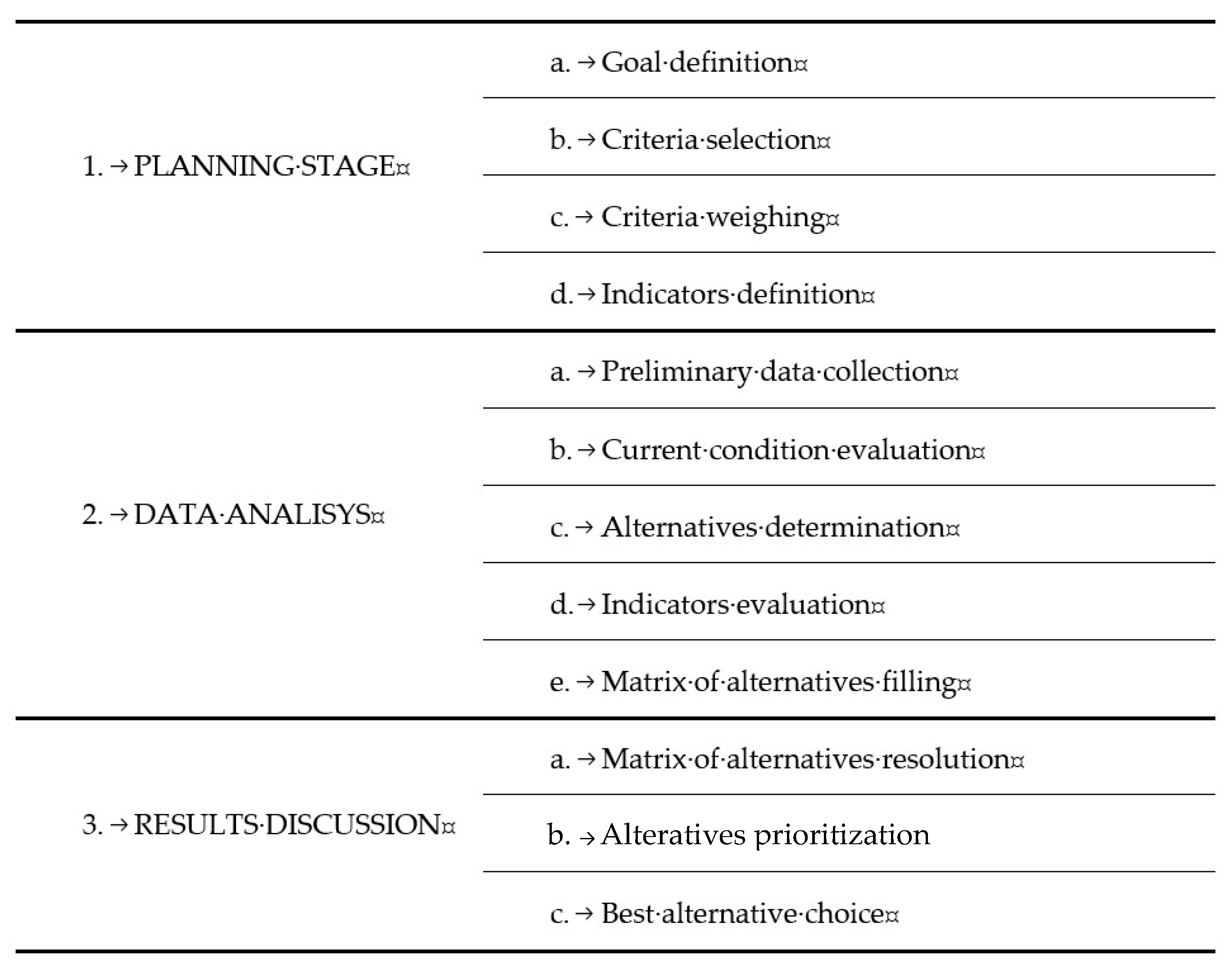
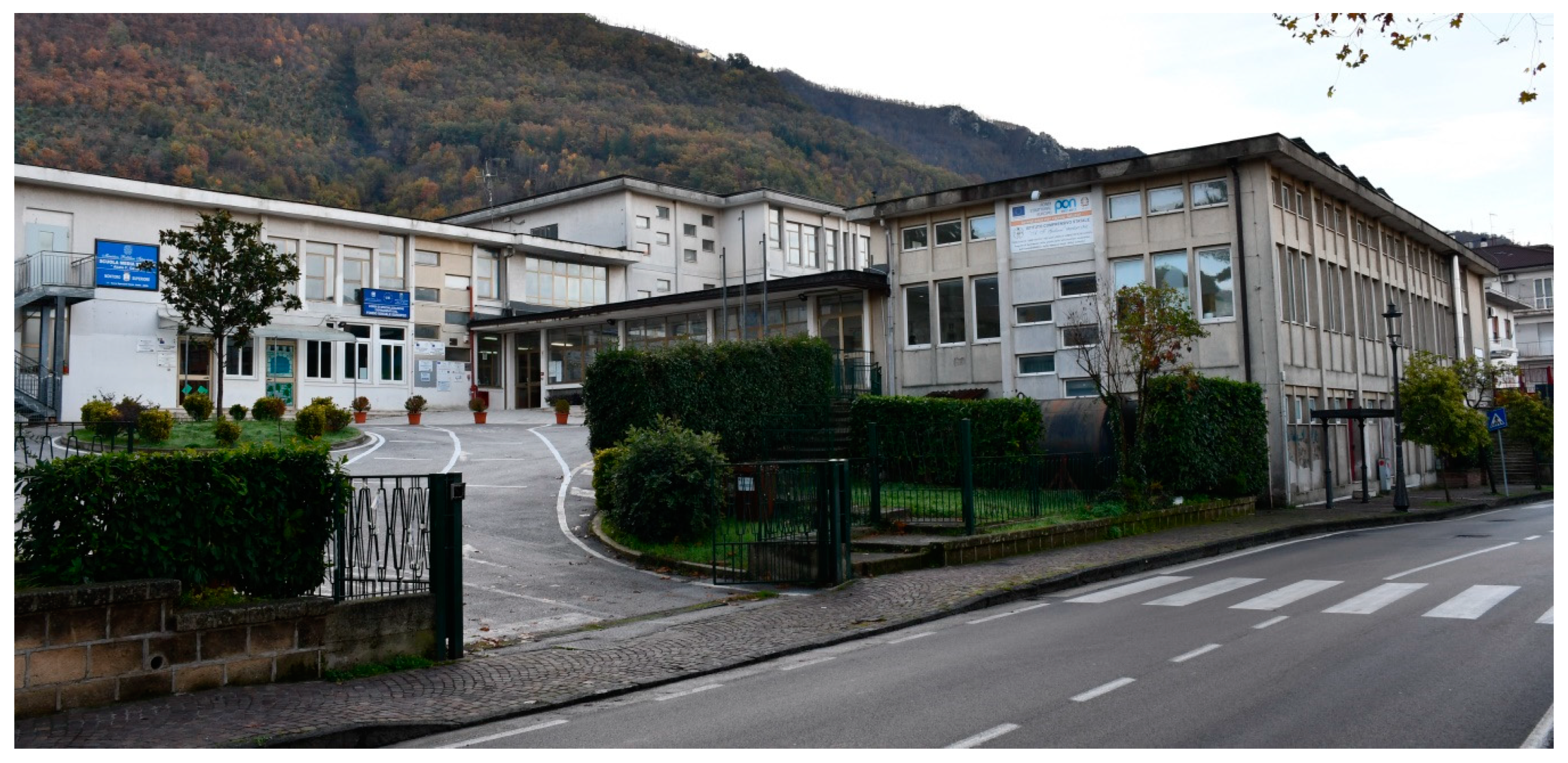
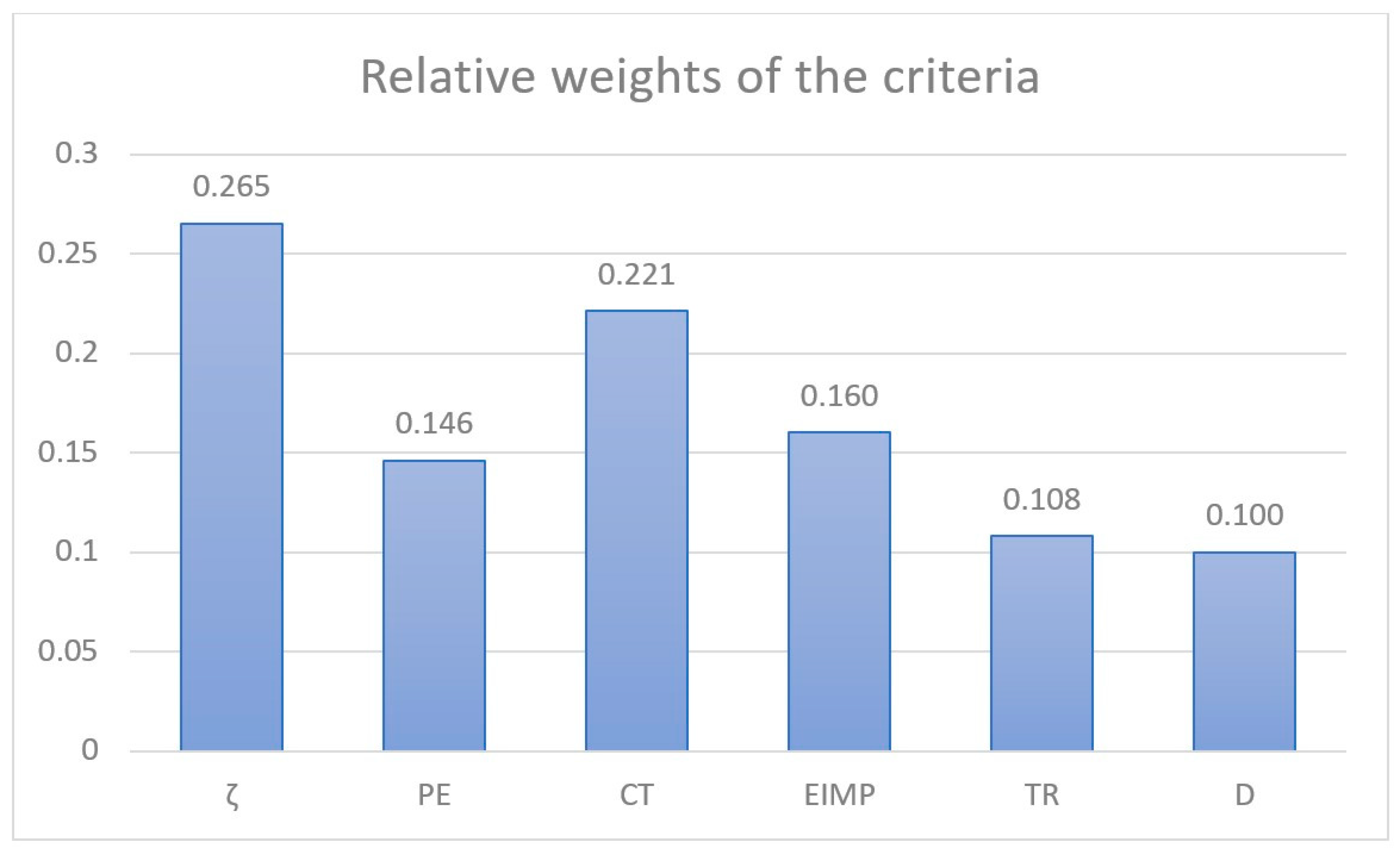
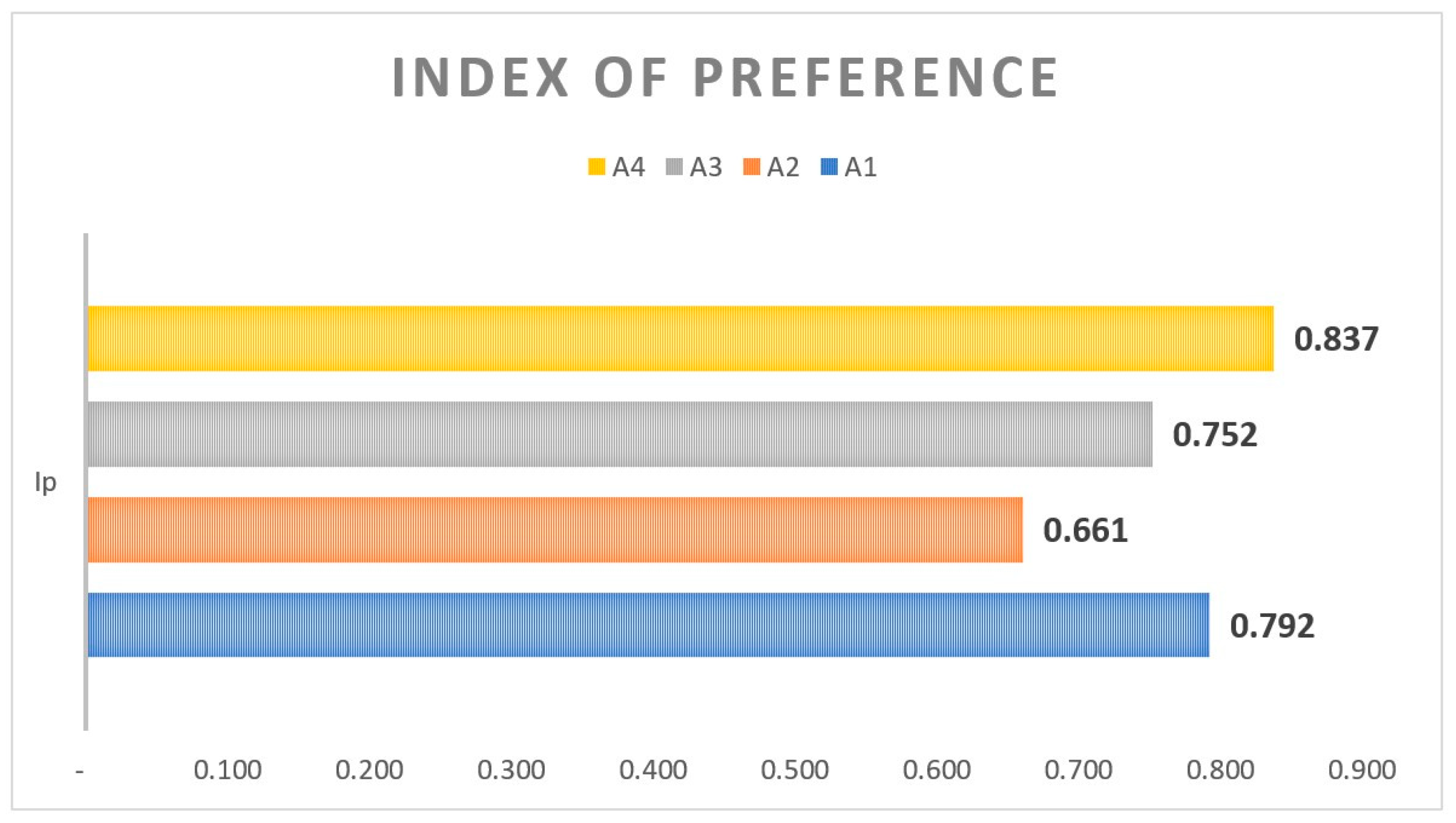
| Interventions/Criteria | C1 | C2 | C3 | C4 | … | Cn |
|---|---|---|---|---|---|---|
| A1 | C1 (A1) | C2 (A1) | C3 (A1) | C4 (A1) | … | Cn (A1) |
| A2 | C1 (A2) | C2 (A2) | C3 (A2) | C4 (A2) | … | Cn (A2) |
| A3 | C1 (A3) | C2 (A3) | C3 (A3) | C4 (A3) | … | Cn (A3) |
| … | … | … | … | … | … | … |
| An | C1 (An) | C2 (An) | C3 (An) | C4 (An) | … | Cn (An) |
| Interventions/Criteria | C1 | C2 | C3 | C4 | … | Cn |
|---|---|---|---|---|---|---|
| A1 | M11 | M12 | M13 | M14 | … | M1m |
| A2 | M21 | M22 | M23 | M24 | … | M2m |
| A3 | M31 | M32 | M33 | M34 | … | M3m |
| … | … | … | … | … | … | … |
| An | Mn1 | Mn2 | Mn3 | Mn4 | … | Mnm |
| Criterion | Indicator | Unit of Measurement | Objective Function |
|---|---|---|---|
| Seismic safety level | Ratio between capacity and seismic demand | adim. | maximize |
| Energy performance | Energy class | kWh/m2 per year | maximize |
| Intervention cost | Total costs | € | minimize |
| Environmental impact | Waste production and recycling | t | minimize |
| Realization time | Estimated working time | Working days | minimize |
| Disturbance | Interactions with school activities | adim. | minimize |
| Building Element | Investigated Characteristic |
|---|---|
| Heating system | Typology Fuel Performance Energy vector |
| Lighting | Illuminating elements Elements number |
| Renewable Sources | Typology Use Accumulation Presence Power Energy vector |
| Opaque vertical outward facing structures | Typology Material Maintenance status Thermal transmittance U [W/m2K] |
| Horizontal opaque roof structures | Typology Material Maintenance status Thermal transmittance U [W/m2K] |
| Opaque horizontal floor structures towards the outside | Typology Material Maintenance status Thermal transmittance U [W/m2K] |
| Transparent and opaque technical closures | Typology Material Maintenance status Thermal transmittance U [W/m2K] |
| Disturbance Level | Description | Score |
|---|---|---|
| Low | Intervention that does not require the occupation of premises and does not involve the activities’ interruption. The interventions, given their type and entity, can be carried out outside the activities’ hours and/or with techniques that have a minimal impact in terms of space occupation. | 0.125 |
| Medium | Intervention that requires the occupation of premises and involves the temporary suspension of activities or their reorganization (e.g., alternating morning/afternoon classes). The user is, however, received by the facility during the intervention. | 0.375 |
| Medium-high | Intervention that requires the occupation of premises and involves the temporary interruption of activities or their reorganization (e.g., alternating morning/afternoon classes). Part of the user must be relocated to another suitable facility. | 0.625 |
| High | Intervention that requires the total occupation of the facility and does not allow any activity. The whole user must be relocated to another suitable facility. | 0.875 |
| Investigated Characteristic | Method | Results |
|---|---|---|
| Construction year | documental analysis | 1960–67 Structural consolidation: 1980–85 |
| Structural typology | documental analysis, survey | Elevating structure: beams, pillars, reinforced concrete stiffening baffles. Foundations: reinforced concrete plinths connected by grade beams |
| Structural safety | survey, pacometric analysis, thermographic analysis, simulated design, linear static analysis | Safety factor ζ = 0.499. |
| Building elements status | analysis sheets | Widespread degradation state |
| Energy performance | energy performance certificate | Class “G” |
| Surface/volume | documental analysis, survey | S = 1865 m2 V = 7120 m3 |
| Destination | survey | 18 classrooms |
| Interventions/Criteria | ζ | EP | CT | EIMP | TR | D |
|---|---|---|---|---|---|---|
| R/E | kWh/m2 per Year | € | adim. | Days | Score | |
| A1 | 1.01 | 119,872 | 2.765.56621 | 0.504 | 57 | 0.625 |
| A2 | 1.01 | 60,383 | 2.851.75793 | 0.136 | 90 | 0.625 |
| A3 | 1.28 | 16,687 | 3.068.04700 | 0.156 | 290 | 0.875 |
| A4 | 1.28 | 16,687 | 3.504.49900 | 0.511 | 300 | 0.875 |
| Interventions/Criteria | ζ | EP | CT | EIMP | TR | D |
|---|---|---|---|---|---|---|
| R/E | kWh/m2 per Year | € | adim. | Days | Score | |
| Weight (w) | 0.265 | 0.146 | 0.221 | 0.160 | 0.108 | 0.100 |
| A1 | 1.01 | 119,872 | 2.765.56621 | 0.504 | 57 | 0.625 |
| A2 | 1.01 | 60,383 | 2.851.75793 | 0.136 | 90 | 0.625 |
| A3 | 1.28 | 16,687 | 3.068.04700 | 0.156 | 290 | 0.875 |
| A4 | 1.28 | 16,687 | 3.504.49900 | 0.511 | 300 | 0.875 |
Publisher’s Note: MDPI stays neutral with regard to jurisdictional claims in published maps and institutional affiliations. |
© 2020 by the authors. Licensee MDPI, Basel, Switzerland. This article is an open access article distributed under the terms and conditions of the Creative Commons Attribution (CC BY) license (http://creativecommons.org/licenses/by/4.0/).
Share and Cite
Fiore, P.; Donnarumma, G.; Falce, C.; D’Andria, E.; Sicignano, C. An AHP-Based Methodology for Decision Support in Integrated Interventions in School Buildings. Sustainability 2020, 12, 10181. https://doi.org/10.3390/su122310181
Fiore P, Donnarumma G, Falce C, D’Andria E, Sicignano C. An AHP-Based Methodology for Decision Support in Integrated Interventions in School Buildings. Sustainability. 2020; 12(23):10181. https://doi.org/10.3390/su122310181
Chicago/Turabian StyleFiore, Pierfrancesco, Giuseppe Donnarumma, Carmelo Falce, Emanuela D’Andria, and Claudia Sicignano. 2020. "An AHP-Based Methodology for Decision Support in Integrated Interventions in School Buildings" Sustainability 12, no. 23: 10181. https://doi.org/10.3390/su122310181
APA StyleFiore, P., Donnarumma, G., Falce, C., D’Andria, E., & Sicignano, C. (2020). An AHP-Based Methodology for Decision Support in Integrated Interventions in School Buildings. Sustainability, 12(23), 10181. https://doi.org/10.3390/su122310181






